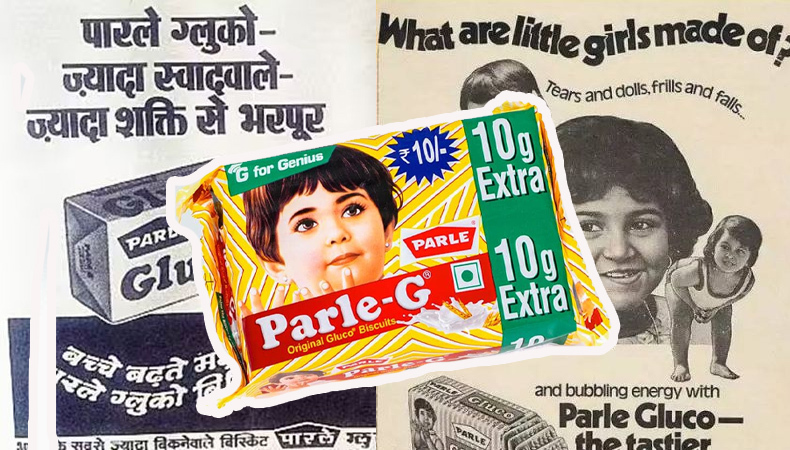Since 1929 – Parle-G is The Taste of India, How?

There’s a good chance that if you’re Indian, you’ve had a Parle-G biscuit.
For anyone who grew up in an Indian home, the mildly sweet, malty, and crisp treat continues to evoke memories of nostalgia 84 years after the first “glucose biscuit” was baked. According to Mumbai-based entrepreneur and culinary anthropologist Kurush Dalal, Parle-G is the “taste of childhood” for the majority of Indians. The biscuit is ubiquitous and pervasive throughout the nation. In cities, small towns, and rural areas, you can find it in supermarkets, roadside stalls, and shops. The dependable staple is a special equalizer and one of the best-selling biscuits in the entire world.
“Breaking open a packet is a continued tradition across the classes and masses, from the 1970s to children today,” claims Dalal. The brand has become a cultural and nostalgic touchpoint for generations of Indians, including those in the diaspora, over the years, and the biscuit has become a part of India’s cultural consciousness. The House of Parle-G started small but has grown to offer a variety of baked goods, confectionery, cakes, rusks, and snacks. In 1929, Mohanlal Dayal Chauhan launched it. The first factory, which had 12 workers, specialized in confections. The business produced Parle Gluco, its first biscuit, in 1938.
Patriotic flavor
The company has Swadeshi (self-sufficiency) ideals at its core. Chauhan decided to participate in the civil disobedience strategy used by the Indian independence movement, which was based on Mahatma Gandhi’s non-cooperation philosophy.
According to Mayank Shah, senior category head at Parle-G Products, the founder of the company learned that the culture of eating biscuits was widespread in most homes after traveling to Europe. According to Shah, eating biscuits in upper-class homes was considered to be an elitist practice in India. He decided to change course and launch a brand that was affordable for everyone to make sure that every Indian could afford a biscuit.
With Chauhan’s business, Indians could no longer rely on imported goods, particularly the pricey and exclusive wealthy British-made biscuits.
Following India’s independence in 1947, Parle began promoting its Gluco biscuits as a non-British alternative to British brands.
Success’s flavor
There are no frills included in a Parle-G packet, which is easily recognized by its yellow-striped packaging and baby mascot. Here, you won’t find any cream, chocolate, or dried fruit. The rectangular biscuit is bordered by an ornamental border and only has its name imprinted in the center.
Over the years, the manufacturing procedure has also stayed the same. A particular concoction of wheat flour, milk powder, sugar, salt, palm oil, preservatives, and flavoring is baked for eight minutes at a temperature of up to 280 °C.
According to Shah, who asserts that baking and biscuits were not traditionally a part of the country’s culinary history, Parle-G is responsible for the biscuit-eating culture in India.
The company’s biscuits were initially known as Parle Gluco until 1985 when it changed its name to Parle-G. Originally the “G” stood for “glucose,” but in a later campaign it was called the “G for genius.” A marketing campaign featuring the Indian superhero Shaktimaan in the late 1990s increased sales from 50 tonnes to 2,000 tonnes per month.
Keep Reading
According to a Nielsen survey from 2011, Parle-G was one of the top-selling biscuit brands worldwide. It was the first fast-moving consumer goods company in India to reach retail sales of Rs 5,000 crore ($600 million) in 2013.
Despite the 2016 closure of Parle’s flagship factory in Vile Parle, the Mumbai suburb from which the company took its name, many customers still remember the aroma of freshly baked biscuits filling the air as they passed by.
Sense of recognizability
The pandemic changed the course of events for Parle-G.
People wanted to cling to the familiar during this period of unpredictability and insecurity. There was a shortage of cookies at shops and supermarkets. Parle-G was chosen by government and non-government organizations for food relief packages, resulting in phenomenal growth for the company.
According to Shah, “We saw one of the highest growth spurts in recent times; we haven’t seen anything like it,” and “people trusted the brand and it had a long shelf life” helped with sales.
During the lockdown, Parle saw a 5% increase in market share. The company gave out 30 million packets to migrants returning home after India tightened its borders in response to COVID-19 even as packets were flying off the shelves. The action generated a great deal of goodwill.
“People are now playing back what we always said: Parle-G is ‘Bharat ka apna biscuit’ [India’s biscuit]. It inspired a great deal of love and touched people from all social classes, says Shah.
At this time, the Parle-G brand is worth Rs. 5 billion. There are 120 of these factories in India, and each day, 400 million biscuits are baked there. According to Shah, there are approximately one billion Parle-G packs produced each month and up to 4,551 Parle-G biscuits are consumed every second. Additionally, the biscuit is exported to 100 nations, including the UAE.
According to Ajay Chauhan, the executive director of the company, “most people know the company as Parle-G” because of how well-known the brand has become.
Everyone’s accessibility and affordability have been guaranteed by the pricing and robust distribution network. The biscuits are sold in multiple packs starting at just Rs2 ($0.02) and are stocked in seven million stores throughout India.
Dalal attributes the brand’s popularity to the fact that the business created a product that appealed to a common consumer desire: value for money.
The biscuits were simple to fit into handbags, tiffins, and dabbas because they were offered in even very small sizes. According to him, the price “meant that they equalized the market between the rich and the poor.
different flavors and recipe modifications
Over time, Parle developed several products, including the biscuits Monaco, Krackjack, and Cheeselings; the candies Kismi, Poppins, and Melody; and the premium Platina line, which includes Hide & Seek, Milano, and Nutricrunch. But the flagship flavor of Parle-G is still the original, not more recent iterations like oats and berries or cinnamon.
The basic ingredient in the pantry is now utilized in various ways. Parle-G is being experimented with by chefs and home cooks, and upscale restaurants are using it in milkshakes and desserts. During the recent visit of Indian Prime Minister Narendra Modi to the US, Parle-G was even included on a lunch menu at the White House. The biscuits served as the foundation for the mango halwa.
Hundreds of recipes for Parle-G desserts, including cookie butter, Swiss rolls, pies, tiramisu, panna cotta, and ice cream sandwiches, are available online.
According to chef and author Anahita Dhondy, the biscuit has “an extremely versatile nature” that makes it suitable for use in a variety of recipes. her preferred? Two favorite Indian flavors are combined in a Parle-G and mango cheesecake.
Parle G is not our property; rather, consumers own it and each of them has a unique memory and story connected to the biscuit, according to Shah.







